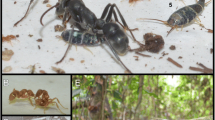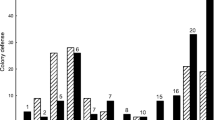Abstract
Group formation and recognition mechanisms can strongly influence the decision to cooperate or attack in animal societies. Therefore, testing how individuals recognize group membership, and the decision to cooperate or attack during social interactions is critical to understanding the evolution of sociality. We explore decision-making in the weaver ant Oecophylla smaragdina, a highly territorial and also cooperative species. Here, we report a previously undescribed rescue behavior for weaver ants, and determine the role of distance and group membership in residents’ decisions to either rescue or attack conspecifics in distress. First, we tested if residents preferentially rescued nestmates and attacked non-nestmates. Our results show that rescue was more likely for nestmates; however, surprisingly, conspecifics from neighboring colonies were rescued in 43% of the distress trials. Furthermore, attacks became more frequent as distance between colonies increased showing a dear enemy effect, which may be explained by familiarity, odor recognition, and/or relatedness. Our work exploring the factors that influence the decision to rescue or attack provides novel evidence to understand the underlying selective pressures that shape decisions of cooperation or conflict in highly cooperative societies.



Similar content being viewed by others
References
Adams ES (1990) Boundary disputes in the territorial ant Azteca trigona: effects of asymmetries in colony size. Anim Behav 39:321–328
Azuma N, Ogata K, Kikuchi T, Higashi S (2006) Phylogeography of Asian weaver ants, Oecophylla smaragdina. Ecol Res 21:126–136
Bee MA (2003) A test of the “dear enemy effect” in the strawberry dart-poison frog (Dendrobates pumilio). Behav Ecol Sociobiol 54:601–610
Benedek K, Kóbori OT (2014) Nasty neighbor’effect in Formica pratensis Retz. (Hymenoptera: Formicidae). North West. J Zool 10(2):245–250
Bourke AF, Franks NR (1995) Social evolution in ants. Princeton University Press, Princeton
Brown JL (1969) Territorial behavior and population regulation in birds: a review and re-evaluation. Wilson Bull 81:293–329
Bruschini C, Cervo R, Cini A, Pieraccini G, Pontieri L, Signorotti L, Turillazzi S (2011) Cuticular hydrocarbons rather than peptides are responsible for nestmate recognition in Polistes dominulus. Chem Senses 36:715–723
Christensen C, Radford AN (2018) Dear enemies or nasty neighbors? Causes and consequences of variation in the responses of group-living species to territorial intrusions. Behav Ecol 29:1004–1013
Crozier RH, Newey PS, Schluens EA, Robson SK (2010) A masterpiece of evolution–Oecophylla weaver ants (Hymenoptera: Formicidae). Myrmecol News 13(13):57–71
Czechowski W, Godziñska EJ, Kozłowski MW (2002) Rescue behavior shown by workers of Formica sanguinea Latr., F. fusca L. and F. cinerea Mayr (Hymenoptera: Formicidae) in response to their nestmates caught by an ant lion larva. Ann Zool 52:423–31
Dani FR (2009) Cuticular lipids as semiochemicals in paper wasps and other social insects. Ann Zool Fennici 500–514
Dimarco RD, Farji-Brener AG, Premoli AC (2010) Dear enemy phenomenon in the leaf-cutting ant Acromyrmex lobicornis: behavioral and genetic evidence. Behav Ecol 21:304–310
Dugatkin LA (1997) Cooperation among animals: an evolutionary perspective. Oxford University Press, Oxford
Errard C, Hefetz A, Jaisson P (2006) Social discrimination tuning in ants: template formation and chemical similarity. Behav Ecol Sociobiol 59:353–363
Faulkes CG, Bennett NC (2001) Family values: group dynamics and social control of reproduction in African mole-rats. Trends Ecol Evol 16:184–190
Fletcher DJ, Michener CD (1987) Kin recognition in animals. Wiley, New York
Frank ET, Schmitt T, Hovestadt T, Mitesser O, Stiegler J, Linsenmair KE (2017) Saving the injured: rescue behavior in the termite-hunting ant Megaponera analis. Sci Adv 3:e1602187
Frank ET, Wehrhahn M, Linsenmair KE (2018) Wound treatment and selective help in a termite-hunting ant. Proc R Soc B 1872:20172457
Gamboa GJ (1978) Intraspecific defense: advantage of social cooperation among paper wasp foundresses. Science 199:1463–1465
Gaston A (1978) The evolution of group territorial behavior and cooperative breeding. Am Nat 112:1091–1100
Grant PR (1998) Evolution on islands. Oxford University Press, Oxford
Heinze J, Hölldobler B, Peeters C (1994) Conflict and cooperation in ant societies. Naturwissenschaften 81:489–497
Holldobler B (1983) Territorial behavior in the green tree ant (Oecophylla smaragdina). Biotropica 241–250
Hölldobler B, Lumsden CJ (1980) Territorial strategies in ants. Science 210:732–739
Hölldobler B, Wilson EO (1990) The ants. Harvard University Press, Cambridge
Hollis KL, Nowbahari E (2013) A comparative analysis of precision rescue behaviour in sand-dwelling ants. Anim Behav 85:537–544
Isbell LA (1991) Contest and scramble competition: patterns of female aggression and ranging behavior among primates. Behav Ecol 2:143–155
Jaeger RG (1981) Dear enemy recognition and the costs of aggression between salamanders. Am Nat 117:962–974
Kamhi JF, Nunn K, Robson SK, Traniello JF (2015) Polymorphism and division of labour in a socially complex ant: neuromodulation of aggression in the Australian weaver ant, Oecophylla smaragdina. Proc R Soc B 1811:20150704
Lokkers C (1990) Colony dynamics of the green tree ant (Oecophylla smaragdina Fab.) in a seasonal tropical climate. James Cook University, Townsville
McCreery HF, Breed M (2014) Cooperative transport in ants: a review of proximate mechanisms. Insectes Soc 61:99–110
Miler K, Symonowicz B, Godzińska EJ (2017a) Increased risk proneness or social withdrawal? The effects of shortened life expectancy on the expression of rescue behavior in workers of the ant Formica cinerea (Hymenoptera: Formicidae). J Insect Behav 30:632–644
Miler K, Yahya BE, Czarnoleski M (2017b) Pro-social behaviour of ants depends on their ecological niche—rescue actions in species from tropical and temperate regions. Behav Process 144:1–4
Monnin T, Ratnieks FL, Brandão CR (2003) Reproductive conflict in animal societies: hierarchy length increases with colony size in queenless ponerine ants. Behav Ecol Sociobiol 54:71–79
Moore D, Liebig J (2010) Mechanisms of social regulation change across colony development in an ant. BMC Evol Biol 10:328
Mora-Kepfer F (2014) Context-dependent acceptance of non-nestmates in a primitively eusocial insect. Behav Ecol Sociobiol 68:363–371
Müller CA, Manser MB (2007) ‘Nasty neighbours’ rather than ‘dear enemies’ in a social carnivore. Proc R Soc B 274:959–965
Müller JK, Eggert A-K, Elsner T (2003) Nestmate recognition in burying beetles: the “breeder’s badge” as a cue used by females to distinguish their mates from male intruders. Behav Ecol 14:212–220
Newey P (2011) Not one odour but two: a new model for nestmate recognition. J Theor Biol 270:7–12
Newey P, Robson S, Crozier R (2008) Near-infrared spectroscopy identifies the colony and nest of origin of weaver ants, Oecophylla smaragdina. Insectes Soc 55:171–175
Newey PS, Robson SK, Crozier RH (2010) Weaver ants Oecophylla smaragdina encounter nasty neighbors rather than dear enemies. Ecology 91:2366–2372
Nowbahari E, Hollis KL (2010) Rescue behavior: distinguishing between rescue, cooperation and other forms of altruistic behavior. Commun Integr Biol 3:77–79
Nowbahari E, Scohier A, Durand JL, Hollis KL (2009) Ants, Cataglyphis cursor, use precisely directed rescue behavior to free entrapped relatives. PLoS One 4(8):e6573
Peng R, Christian K, Gibb K (1998) Locating queen ant nests in the green ant, Oecophylla smaragdina (Hymenoptera, Formicidae). Insectes Soc 45:477–480
Queller DC, Strassmann JE (1998) Kin selection and social insects. Bioscience 48:165–175
R Development Core Team (2011) R: A language and environment for statistical computing. R Foundation for Statistical Computing, Vienna. http://www.R-project.org
Rainbow WJ (1913) Arachnida from the Solomon Islands. Rec Aust Mus 10:1–16
Reeve HK (1989) The evolution of conspecific acceptance thresholds. Am Nat 133:407–435
Sachs L (1992) Angewandte statistik: anwendung statischr methoden. Springer, Berlin
Schlick-Steiner BC et al (2006) A multidisciplinary approach reveals cryptic diversity in Western Palearctic Tetramorium ants (Hymenoptera: Formicidae). Mol Phylogenetics Evol 40:259–273
Schlüns E, Wegener B, Schlüns H, Azuma N, Robson S, Crozier R (2009) Breeding system, colony and population structure in the weaver ant Oecophylla smaragdina. Mol Ecol 18:156–167
Singer TL (1998) Roles of hydrocarbons in the recognition systems of insects. Am Zool 38:394–405
Stacey PB, Koenig WD (1990) Cooperative breeding in birds: long term studies of ecology and behaviour. Cambridge University Press, Cambridge
Stubben C, Milligan B (2007) Estimating and analyzing demographic models using the popbio package in R. J Stat Softw 22:1–23
Taylor K, Visvader A, Nowbahari E, Hollis KL (2013) Precision rescue behavior in North American ants. Evol Psych 11:147470491301100312
Tierney A, Andrews K, Happer K, White M (2013) Dear enemies and nasty neighbors in crayfish: Effects of social status and sex on responses to familiar and unfamiliar conspecifics. Behav Process 99:47–51
Traniello JF, Robson SK (1995) Trail and territorial communication in social insects. In: Chemical ecology of insects. pp 241–286
Ward A, Webster M (2016) Sociality: the behaviour of group-living animals. Springer, Berlin
West SA, Griffin AS, Gardner A (2007) Evolutionary explanations for cooperation. Curr Biol 17:R661–R672
West SA, Pen I, Griffin AS (2002) Cooperation and competition between relatives. Science 296:72–75
Wilson EO (1971) The Insect Societies. Harvard University Press, Cambridge
Wilson EO (1975) Sociobiology: the new synthesis. Harvard University Press, Cambridge, The New Synthesis
Ydenberg RC, Giraldeau L-A, Falls JB (1988) Neighbours, strangers, and the asymmetric war of attrition. Anim Behav 36:343–347
Yusuf A, Gordon I, Crewe R, Pirk CWW (2014) Prey choice and raiding behaviour of the Ponerine ant Pachycondyla analis (Hymenoptera: Formicidae. J Nat Hist 48:345–358
Acknowledgements
We thank the Ministry of Environment, Climate Change, Disaster Management and Metereology for permit RP/2014/002 to conduct fieldwork in the Solomon Islands, the Fagakoro community for access to their land, and the Manutage community for logistical assistance in Star Harbour. Johnson Pepere, George Wabeasi, James Suafuria and Lonsdale Taka provided assistance during fieldwork. Marc Seid, Al Uy, William Searcy, and members of the Uy and Searcy labs provided comments to improve earlier versions of the manuscript. This study was supported by the Biology Department and College of Arts and Sciences at the University of Miami to FMKU, and an Aresty Fund Scholarship awarded to SFJ.
Author information
Authors and Affiliations
Corresponding author
Electronic supplementary material
Below is the link to the electronic supplementary material.
Rights and permissions
About this article
Cite this article
Uy, F.M.K., Adcock, J.D., Jeffries, S.F. et al. Intercolony distance predicts the decision to rescue or attack conspecifics in weaver ants. Insect. Soc. 66, 185–192 (2019). https://doi.org/10.1007/s00040-018-0674-z
Received:
Revised:
Accepted:
Published:
Issue Date:
DOI: https://doi.org/10.1007/s00040-018-0674-z




